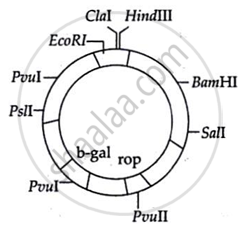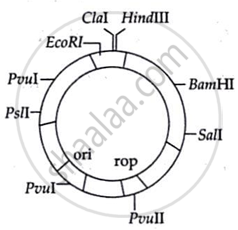Advertisements
Advertisements
प्रश्न
Enlist and write in brief about the different biological tools required in rDNA technology.
उत्तर
The different biological tools required in rDNA technology:
i. Instruments: PCR, Agarose Gel Electrophoresis, SDS-PAGE
Polymerase Chain Reaction (PCR) is the process of in vitro amplification of the gene of interest using a PCR machine.
- PCR can generate a billion copies of the desired segment of DNA or RNA, with high accuracy and specificity, in a few hours.
- The process of PCR is completely automated and involves automatic thermal cycles for denaturation and renaturation of double-stranded DNA.
- The device required for PCR is called a thermal cycler.
Requirements for polymerase chain reaction:
- DNA containing the desired segment to be amplified
- several molecules of four deoxyribonuclueoside triphosphates (dNTPs)
- excess of two primer molecules
- heat-stable DNA polymerase and
- appropriate quantities of Mg++ ions.
DNA replication through a polymerase chain reaction.
ii. Biological tools: Enzymes, Cloning Vectors, Competent host
Different enzymes used in rDNA technology are as follows: Lysozymes, Nucleases such as exonucleases, endonucleases, restriction endonucleases, DNA ligases, DNA polymerases, alkaline phosphatases, reverse transcriptase, etc.
- Enzymes that cut the phosphodiester bonds of polynucleotide chains are called nuclease.
- These are of two types- exonuclease and endonuclease.
- Exonucleases cut nucleotides from the ends of DNA strands whereas endonuclease cut DNA from within.
- The phosphodiester backbone at highly specific sites on both strands of the duplex is cut by these enzymes called restriction endonucleases or simply restriction enzymes.
- The restriction enzymes are thus the molecular scissors that are used to recognize and cut DNA at specific sequences.
- The sites recognized by them, are called recognition sequences or recognition sites.
- Different restriction enzymes found in different organisms recognize different nucleotide sequences and therefore cut DNA at different sites.
The following characteristic properties a cloning vector must possess in order to be used in rDNA technology:
- A good vector should have the ability of independent replication so that as the vector replicates (through ori gene) and a large number of copies of the DNA insert will be formed.
- The vector should be able to easily introduce into host cells.
- A vector should have marker genes for antibiotic resistance.
- A vector must contain a unique cleavage site in one of the marker genes for the restriction enzyme.
- It should have at least suitable control elements like a promoter, operator, ribosomal binding sites, etc.
- The plasmids obtained naturally do not possess all the characteristics. Hence, they are constructed by inserting a gene for antibiotic resistance. e.g. pBR322, pBR320, pACYC177 are the constructed plasmids. pBR322 is mostly used in rDNA technology in plants.
Competent hosts (cloning organisms) used are usually bacteria like Bacillus haemophilus, Helicobacter pylori, and E. coli. Mostly E. coli is used for the transformation with recombinant DNA.
APPEARS IN
संबंधित प्रश्न
What are plasmids?
What is Palindromic sequence?
Identify the palindromic sequence which is recognized by the EcoRI restriction enzyme.
From the following list of cloning vectors used in rDNA technology identify the vectors that are the most commonly used.
Plasmids, bacteriophages (Ml3, lambda virus), cosmid, phagemid, BAC (bacterial artificial chromosome), YAC (yeast artificial chromosome), transposons, baculoviruses, and mammalian artificial chromosomes (MACs)
Which of the following device is required for PCR?
Which of the following is NOT involved in genetic engineering technique?
i. Combining genes from two organisms
ii. Gene cloning
iii. Transfer of lipid molecules
iv. Transfer of genes to new organisms
v. Repairing or replacing the defective genes by healthy genes
vi. Artificial synthesis of new gene
Who among the following was awarded the Nobel Prize for the development of PCR technique?
Which of the following is the correct recognition sequence of restriction enzyme Eco RI?
In vitro amplification of DNA segments is called______.
Suneeta is planning an experiment to clone a gene in a vector. So, she has to choose a good cloning vector.
Which one of the vectors shown below should she choose? Justify your answer by giving two reasons.
 |
 |
 |
| Vector A | Vector B | Vector C |
